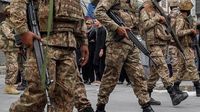In the tumultuous landscape of South Asian geopolitics, the spring and summer of 2025 have brought a fresh wave of diplomatic maneuvering, military posturing, and legislative reforms—particularly for Pakistan and its neighbors. As India and Pakistan, both nuclear-armed states, exchanged intense fire and airstrikes in a four-day conflict that ended with a ceasefire on May 10, the region’s security architecture and political alignments came under renewed scrutiny.
According to the Observer Research Foundation, these hostilities showcased the modern face of warfare: drones, precision-guided munitions, and fighter jets dominated the battlefield, underscoring both countries’ increasing reliance on advanced military technologies. Yet, the repercussions extended well beyond the Line of Control. The conflict prompted not only global concern but also forced neighboring countries—most notably Nepal—to confront their own diplomatic postures and historical entanglements.
At the heart of Pakistan’s response to these shifting dynamics stands Field Marshal Asim Munir. As detailed in DND News, Munir has become the architect of a recalibrated Pakistani foreign policy, one that seeks equilibrium between the United States and China while projecting strength and stability at home and abroad. His leadership has been marked by a careful blend of military diplomacy and strategic engagement, ensuring that Pakistan remains indispensable to both Washington and Beijing without alienating either power.
Munir’s approach is rooted in a pragmatic understanding of Pakistan’s dual dependencies. With China, Islamabad enjoys what’s often called an “all-weather friendship,” deepened through joint military exercises, intelligence sharing, and the China-Pakistan Economic Corridor (CPEC)—a vital artery for Beijing’s Belt and Road ambitions. With the United States, Pakistan’s security and financial sectors have long relied on American aid, military training, and support in international financial institutions. Recognizing this, Munir has worked to restore trust in Washington, emphasizing Pakistan’s role as a counterterrorism partner and a vital stabilizing force on Afghanistan’s volatile border.
“Field Marshal Asim Munir’s diplomatic maneuvers reveal a careful balancing act,” reports DND News. In meetings with U.S. President Trump, Secretary of Defense Lloyd Austin, and CIA Director William J. Burns, Munir reiterated Pakistan’s commitment to combating terrorism and highlighted the need for technical support against cross-border threats. This re-engagement has paid dividends, with U.S. backing during Pakistan’s recent IMF negotiations serving as a tangible sign of improved relations.
Yet, Munir has been equally attentive to China, reinforcing Pakistan’s status as Beijing’s most reliable regional ally. His leadership has seen enhanced defense cooperation, intelligence sharing, and a focus on CPEC as both an economic lifeline and a strategic corridor. By refusing to align fully with either superpower, Munir projects Pakistan as a state pursuing “strategic equilibrium”—a stance increasingly vital amid great power competition.
Recent events have also provided Pakistan with an opportunity to reshape its international image. Following India’s defeat in the May 2025 conflict—dubbed Marka-e-Haq by Pakistani media—Western outlets hailed Munir’s military diplomacy as the dawn of a new era for Islamabad. The U.S. media described him as an “Iron Man,” while Chinese coverage referred to him as “a pillar of national stability.” For a country long maligned as a hub of extremism, these accolades signal a significant reputational shift.
Munir’s diplomatic outreach has extended far beyond the U.S. and China. Over the past year, he has engaged with leaders across the Middle East, Central Asia, and Europe, using military diplomacy as a tool for fostering alliances and enhancing regional security. His visits to Saudi Arabia, the United Arab Emirates, Qatar, Turkey, Iran, and the United Kingdom have focused on defense cooperation, counterterrorism, and economic partnerships. At multilateral forums like the Shangri-La Dialogue in Singapore, Munir has positioned Pakistan as a proactive voice for regional stability and economic growth.
“Field Marshal Asim Munir is projecting the defense capabilities of Pakistan, signaling strength without direct confrontation and through deterrence,” DND News notes. “He sends a message to adversaries that Pakistan shall respond to any attempt of aggression by inflicting damage beyond their acceptable limits, so they must not follow the path of war.”
Domestically, Pakistan has responded to the resurgent militant threat with robust legal reforms. On September 2, President Asif Ali Zardari gave his assent to the Anti-Terrorism (Amendment) Bill, 2025, as reported by Gulf News. This legislation, passed by both chambers of parliament in August, restores powers for law enforcement and the armed forces to detain terrorism suspects for up to three months without formal charges—albeit with judicial oversight and a built-in three-year sunset clause.
Government lawmakers have emphasized the necessity of the amendment in light of recent attacks, including the deadly assault on the Jaffar Express train. “We cannot allow terrorists to roam freely while innocent people are slaughtered in provinces, on trains like the Jaffar Express, or in targeted attacks,” said Senator Irfan Siddiqui. The law requires detainees to be produced before a magistrate within 24 hours and mandates that any detention beyond three months comply with constitutional protections against arbitrary arrest. Investigations are to be conducted by Joint Investigation Teams, comprising police, intelligence agencies, and civil armed forces, and supervised by a senior police officer.
The amended law is part of a broader framework established by the Anti-Terrorism Act of 1997, which grants authorities significant powers to prevent and prosecute terrorism, including warrantless searches and asset freezes. The new amendment, however, aims to strike a balance between effective counterterrorism and the protection of civil liberties, reflecting both domestic pressures and international expectations.
While Pakistan recalibrates its internal and external responses, the regional fallout from the India-Pakistan conflict has been felt acutely in neighboring Nepal. As detailed in the Observer Research Foundation’s September 2025 issue brief, Nepal’s response to the crisis was marked by its characteristic neutrality—even as many Nepali Gurkhas serve in the Indian Army, a legacy of the 1947 tripartite agreement with India and the UK. Nepal’s Foreign Affairs Ministry expressed “deep concern about the escalating tension” and condemned the terrorist attack in Pahalgam that killed a Nepali national, but stopped short of endorsing India’s retaliatory military actions.
The ambiguity of Nepal’s stance reflects a long tradition of balancing between its two powerful neighbors, India and China, and an enduring commitment to non-alignment. While some Nepali politicians and civil society leaders voiced solidarity with India’s fight against terrorism, others cautioned against unilateral military responses and called for restraint, dialogue, and regional cooperation. This internal divergence was mirrored in parliamentary debates and public discourse, revealing the complex interplay of historical ties, domestic politics, and strategic calculations.
Nepal’s careful diplomatic choreography is not new. Throughout its modern history—from the Panchayat era’s cautious neutrality to the era of South Asian regionalism embodied by SAARC—Kathmandu has sought to maintain cordial ties with both India and Pakistan, even during periods of heightened tension. The country’s reluctance to take sides is shaped by its own vulnerabilities, aspirations for sovereign agency, and the recognition that peace and stability in South Asia are prerequisites for its own development.
As the dust settles on the latest India-Pakistan standoff, the region faces a familiar yet ever-evolving set of challenges: the imperative to combat terrorism, the risks of escalation between nuclear powers, and the enduring need for diplomatic agility. For Pakistan, the path forward lies in sustaining its delicate balancing act—projecting strength, securing its borders, and engaging constructively with both global powers and regional neighbors. For Nepal, the test remains one of principled neutrality and proactive engagement, striving to uphold regional peace without sacrificing its own interests or autonomy. The choices these countries make in the months ahead will shape not only their own futures but the broader trajectory of South Asian security and diplomacy.




